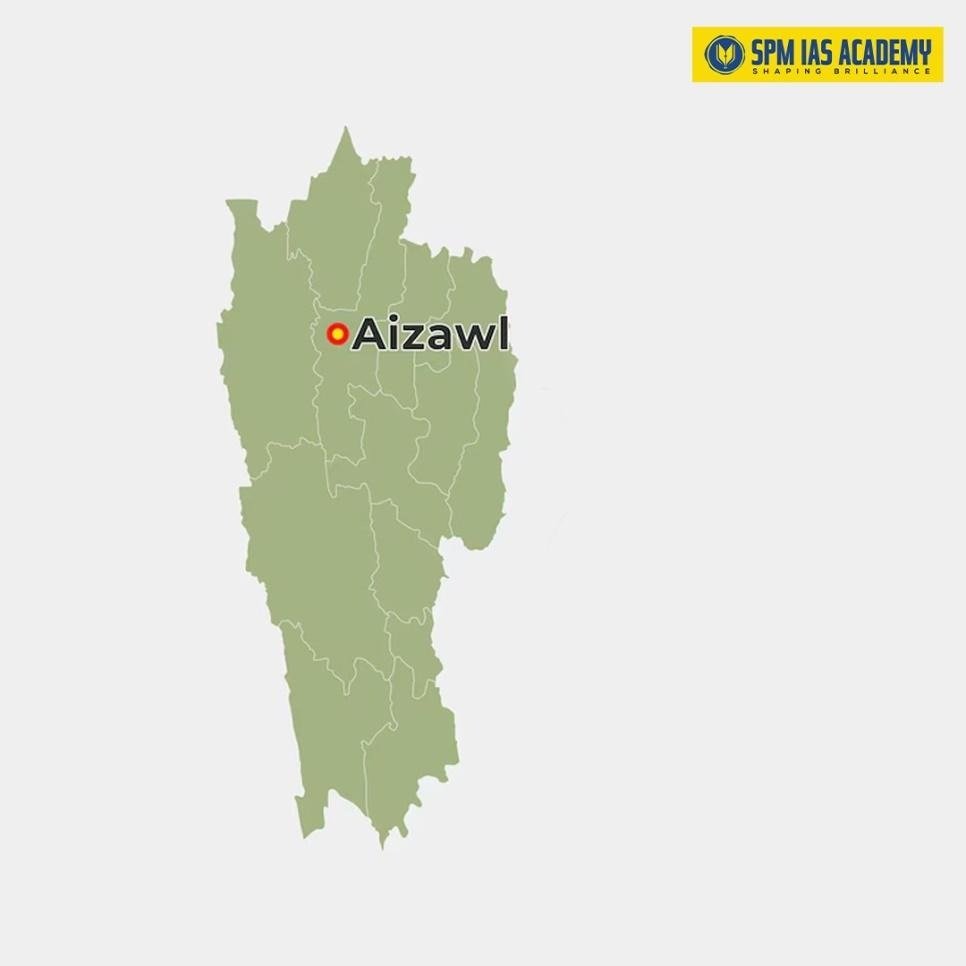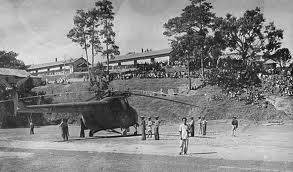Mizoram, one of India’s most picturesque north-eastern states, is known for its rolling hills, rich tribal culture, and high literacy rate. Further, The capital of Mizoram is Aizawl, a beautiful hill city that stands as the political, cultural, and administrative heart of the state.
For UPSC and other State PCS aspirants, knowing about the state capitals of Northeast India and their geography, history, and socio-economic importance is crucial for the Static GK and Indian Geography sections of the exam.
Aizawl: the Capital of Mizoram

- Aizawl, formerly known as Aijal, is the capital of Mizoram and one of the most populous cities in northeast India.
- Moreover, it ranks as the third-largest city in Northeast India, highlighting its growing urban prominence.
- However, situated atop a series of ridges at an average elevation of around 1,132 metres (3,714 feet) above sea level, the city offers a scenic hilly landscape.
- As of 2024, Aizawl’s estimated population stands at around 415,000, reflecting its steady demographic growth and urban development.
- Together with being served as the capital of the British Lushai Hills from 1898 to 1947, we can see the colonial structur prevalent in the city centre. It includes but not limited to the Aijal Club, Raj Bhavan, the Red School, and the Office of the Deputy Commissioner.
- As the seat of the Government of Mizoram, Aizawl is home to the Assembly House.
- Additionally, Aizawl is part of the Smart Cities Mission, an initiative by the Ministry of Housing and Urban Affairs aimed at urban development and infrastructure enhancement.
Historical Background of Aizawl – the Capital of Mizoram:

- The history of Aizawl dates back to the late 19th century during British colonial rule.
- The city was founded in 1890 when the British administration set up a military outpost to control uprisings in the Mizo Hills.
- Moreover, gradually, it developed into a major administrative and commercial center.
- Following India’s independence, Mizoram was initially part of Assam as the Mizo District.
- After the Mizo National Front (MNF) movement, peace was restored with the Mizo Accord of 1986.
- Consequently, Mizoram became a full-fledged state on February 20, 1987, with Aizawl as its capital.
- Historical Background:
- Before the British, Aizawl was a village founded by Chief Lalsavunga around 1810.
- In 1889, Officer Dally of the Assam Police, along with 400 men, arrived in Aizawl village to support Colonel Skinner’s troops during a British military campaign against the Mizo natives.
- Following the operation, Dally recommended Aizawl as a strategic site for a fortified post, recognizing its geographical advantage.
- Acting on this recommendation, Colonel Skinner supervised the construction, ensuring the establishment of stockades and essential structures.
- Furthermore, through their efforts, the British troops built a strong military base, marking the beginning of organized control in the region.
- Consequently, in the same year (1889), the British established Fort Aijal, transforming the small village into the capital of British administration in the North Lushai Hills.
- At last, Aijal was formally established on 25 February 1890 as Fort Aijal.
- Contemporary Aizawl (1948–Present):
- However, from 1948 to 1972, Aizawl served as the capital of the Mizo District in Assam, marking the beginning of its administrative prominence.
- Initially a modest hilltop village, Aizawl expanded rapidly, transforming into a rugged urban settlement.
- During the late 1950s, the Mautam famine drove many people to the city in search of food and livelihood, accelerating its urban growth.
- Further, gradually, nearby villages like Chaltlang and Durtlang became part of the expanding city, shaping Aizawl’s modern skyline by the early 1960s.
- 1966 Mizo National Front Uprising:
- But, in March 1966, the Mizo National Front (MNF) launched an armed rebellion against the Government of India.
- In response, the Indian Air Force bombed Aizawl on 5–6 March 1966, marking the first airstrike by India on its own territory.
- As a result, Aizawl suffered heavy damage and loss of life, while residents fled to nearby jungles for safety.
- Consequently, the city’s expansion came to a halt, and this incident became a defining moment in Mizoram’s history.
- Capital of Mizoram Union Territory (1972–1987)
- Further, after 1972, Aizawl became the capital of the Mizoram Union Territory, ushering in a new phase of governance and growth.
- Finally, The UT status enabled economic development, establishing Aizawl as a commercial and trade hub in Northeast India.
- Burmese Chin immigrants also migrated to Aizawl, seeking better employment opportunities.
- Capital of the State of Mizoram (1987–Present)
- In 1987, Mizoram achieved statehood, and Aizawl became its official capital.
- Statehood brought greater access to central funds and development schemes, boosting infrastructure and services.
Geographical Features of Aizawl, the Capital of Mizoram:

- Location: Aizawl lies in the north-central part of Mizoram, rested on the ridges of the Lushai Hills in Northeast India.
- Elevation: The city stands at an average height of about 1,132 metres (3,714 feet) above sea level.
- Topography: Due to steep and uneven hill slopes, Aizawl features narrow valleys and winding roads, creating a unique urban landscape.
- River System: The Tlawng, Tuirial, and Tuivawl rivers flow near the city, shaping its drainage and supporting local ecosystems.
- Vegetation and Climate: Surrounded by lush green forests and rolling hills, Aizawl experiences a moderate subtropical climate with heavy monsoon rainfall.
Administrative and Political Importance:
- As the capital of Mizoram, Aizawl serves as the centre of the Mizoram government. It houses:
- The Mizoram Legislative Assembly
- The Raj Bhavan (Governor’s House)
- The Chief Minister’s Secretariat
- Important departments of Education, Health, and Home Affairs
Cultural Significance of the Capital of Mizoram – Aizawl:
- Aizawl is a true reflection of Mizo culture and traditions. The majority of its population belongs to the Mizo tribe, known for their warm hospitality and community spirit.
- The Mizo language (Lushai) is widely spoken.
- The city celebrates colorful festivals such as Chapchar Kut, Mim Kut, and Pawl Kut, which mark agricultural and cultural milestones.
- Christianity plays a major role in Mizoram’s social life, and churches are found throughout the city.
Education:
- Mizoram is one of the most literate states in India. It is the first Indian state to attain full functional literacy. It achieved 98.20% literacy as per the PLFS Survey 2023-24.
- Aizawl is its educational hub. Prominent institutions include:
- Mizoram University (Central University)
- National Institute of Technology (NIT), Mizoram
- Regional Institute of Paramedical and Nursing Sciences (RIPANS)
Economy of Aizawl:
- The economy of Aizawl is mainly driven by agriculture, government services, handicrafts, and small-scale industries.
- Bamboo products, handloom fabrics, and traditional Mizo crafts are famous across the region.
Tourism in Aizawl:

- Aizawl attracts nature lovers and culture enthusiasts from across India.
- Top tourist destinations include:
- Durtlang Hills – Offers panoramic views of the city
- Mizoram State Museum – Displays tribal artifacts, traditional attire, and musical instruments
- Solomon’s Temple – One of the most magnificent churches in Mizoram
- Reiek Tlang – A scenic hill and cultural village located 30 km from Aizawl
- Bara Bazar – The main market offering local crafts and ethnic wear
Connectivity:
- Being the capital of Mizoram, Aizawl is well-connected to the rest of India:
- Recently, in August, 2025, the Capital of Mizoram, Aizawl got railway connectivity with the rest of India via Bairabi – Sairang rail line. It is the 4th North-eastern state capital with rail connectivity after Assam (Dispur), Tripura (Agartala) and Arunachal Pradesh (Itanagar).
- Air: Lengpui Airport, 32 km away from Aizawl, connects the city to Guwahati, Kolkata, and Delhi.
- National Highway 54 links Aizawl to Silchar (Assam) and other major northeastern towns.
Conclusion:
To summarize, Aizawl is the capital of Mizoram, a city that beautifully blends nature, tradition, and progress. From its historical origins to its role as a modern administrative centre, Aizawl represents the spirit of Mizoram.
Sources:
Latest Articles
| Article Title | Read More |
|---|---|
| Top 10 UNESCO World Heritage Sites in India | Read Article |
| Special Agencies of United Nations | Read Article |
| Tiger Reserves in India | Read Article |
| Neighboring Countries of India | Read Article |
| Middle East Countries | Read Article |
| Top 10 Highest Mountain Peaks in India | Read Article |
| 10 Most Powerful Countries in the World by Military Strength | Read Article |












